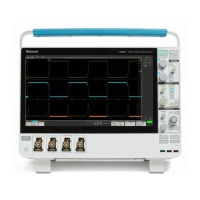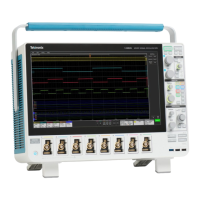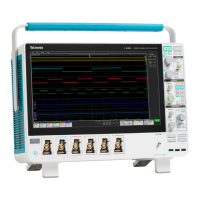Commands listed in alphabetical order
TRIGger:A:BUS
:B1:AUDio:DATa:VALue?
might
return
:TRIGGER:A:BUS:B1:AUDIO:DATA :VALUE
"XXXXXXXXXXXXXXXXXXXXXXXX "
indicating the data value is
XXXXXXXXXXXXXXXXXXXXXXXX.
TRIGger:{A|B}:BUS:B<x>:AUDio:DATa:WORD
This command sets the alignment of the data (left, right or either) to be used to
trigger on an audio bus signal. The trigger condition must b e set to DATa using
TRIGger:{A|B}:BUS:B<x>:AUDio:CONDition.
The bus number is specified by <x>.
Conditions
Requires the SR-AUDIO Triggering and Analysis application.
Group
Trigger
Syntax
TRIGger:{A|B}:BUS:B<x>:AU Dio:DATa:WORD {EITher|LEFt|R IGht}
TRIGger:{A|B}:BUS:B<x>:AU Dio:DATa:WORD?
Arguments
EITher aligns the trigger data to either left or right.
LEFt aligns the trigger data to the left.
RIGht aligns the trigger data to the right.
Examples
TRIGger:A:BUS:B1:AUDio:DA Ta:WORD LEFt sets the word alignment to
the left.
TRIGger:A:BUS:B1:AUDio:DA Ta:WORD? might return
:TRIGGER:A:BUS:B1:AUDIO:D ATA:WORD EITHER indicating the
trigger data is aligned to either left or right.
TRIGger:{A|B}:BUS:B<x>:CAN:CONDition
This command sets the condition (start of frame, frame type, identifier, matching
data,EOF,missingACKfield, bit-stuffing error) to be used when triggering on a
CAN bus signal. The bus number is specified by <x>.
Conditions
Requires the SR-AUTO Triggering and Analysis application.
Group
Trigger
2-770 MSO54, MSO56, MSO58, MSO58LP Programmer













